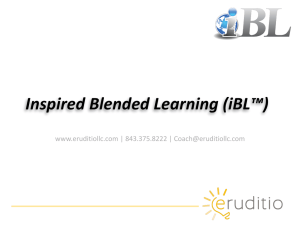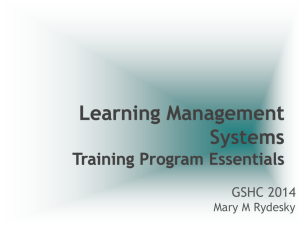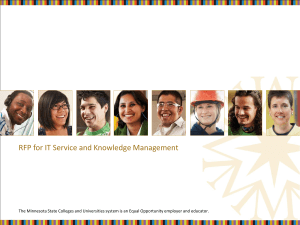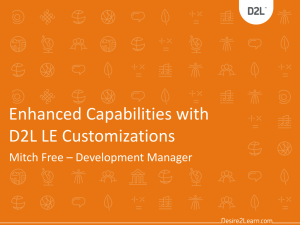appendix k. functional requirements
advertisement
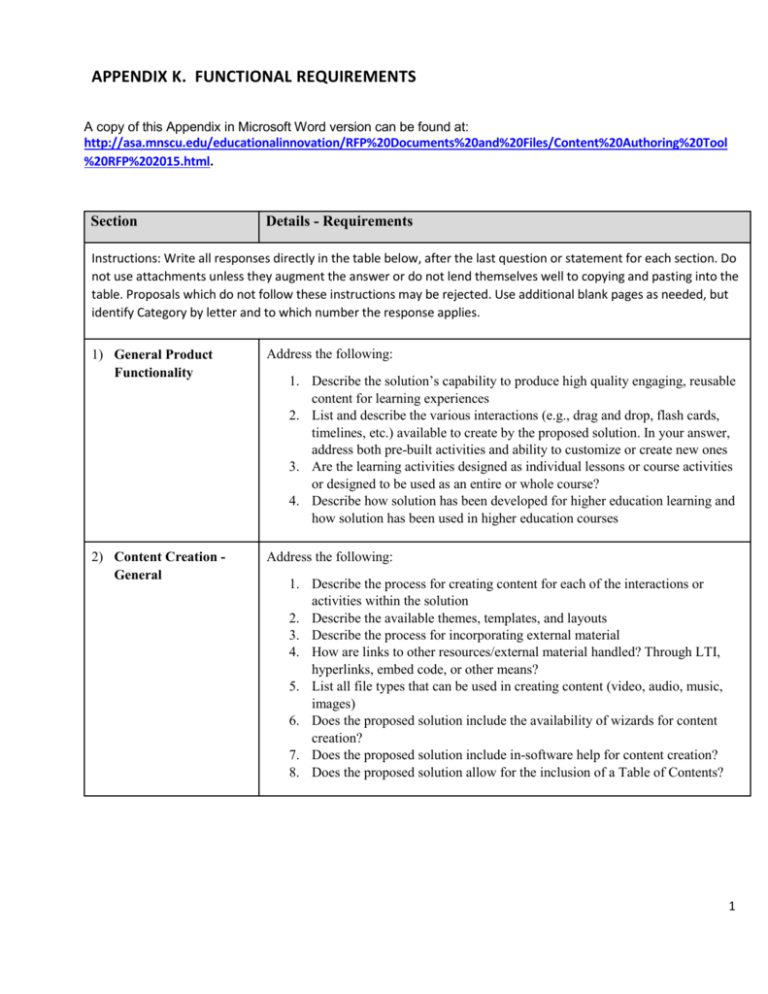
APPENDIX K. FUNCTIONAL REQUIREMENTS A copy of this Appendix in Microsoft Word version can be found at: http://asa.mnscu.edu/educationalinnovation/RFP%20Documents%20and%20Files/Content%20Authoring%20Tool %20RFP%202015.html. Section Details - Requirements Instructions: Write all responses directly in the table below, after the last question or statement for each section. Do not use attachments unless they augment the answer or do not lend themselves well to copying and pasting into the table. Proposals which do not follow these instructions may be rejected. Use additional blank pages as needed, but identify Category by letter and to which number the response applies. 1) General Product Functionality Address the following: 2) Content Creation General Address the following: 1. Describe the solution’s capability to produce high quality engaging, reusable content for learning experiences 2. List and describe the various interactions (e.g., drag and drop, flash cards, timelines, etc.) available to create by the proposed solution. In your answer, address both pre-built activities and ability to customize or create new ones 3. Are the learning activities designed as individual lessons or course activities or designed to be used as an entire or whole course? 4. Describe how solution has been developed for higher education learning and how solution has been used in higher education courses 1. Describe the process for creating content for each of the interactions or activities within the solution 2. Describe the available themes, templates, and layouts 3. Describe the process for incorporating external material 4. How are links to other resources/external material handled? Through LTI, hyperlinks, embed code, or other means? 5. List all file types that can be used in creating content (video, audio, music, images) 6. Does the proposed solution include the availability of wizards for content creation? 7. Does the proposed solution include in-software help for content creation? 8. Does the proposed solution allow for the inclusion of a Table of Contents? 1 3) Content Creation Importing Address the following: 4) Content Creation – Integrations and Open Standards (3rd party products) Address the following: 1. List all file types that can be imported into the proposed solution 2. Describe the process for importing all file types 3. List and describe any restrictions on importing files or file types. Are any file types not permitted to be imported or used within the proposed solution? 1. Does the proposed solution have the ability to import, maintain, and export data to integrate and interact with other data systems, such as student, program, department, and college level databases? 2. Does the proposed solution have the ability to import, maintain, and export data to integrate and interact with college SIS systems and/or system-level data warehouses 3. Propose and provide evidence of the solution’s ability to integrate with other programs and platforms. 4. List the proposed solution’s standards for integrating with other systems. Include the degree of support offered for each of the standards followed/supported 5. Please list current integrations with third party products. Describe the integration process for each 6. What product integrations are being planned for the next 2-3 years? 7. Describe the data privacy and information security measures in place for integrations 2 5) Content Creation – SCORM Address the following: 1. Describe whether the proposed solution will permit the repurposing and importing of digitized elements or learning objects from an existing course for use in a new course 2. List all open standards proposed solution supports which enable interoperability between the proposed solution and other platforms or software, such as LMSs 3. Does proposed solution support the Common Cartridge standards? 4. Does proposed solution support SCORM standards and specifications? 5. Describe the process for faculty to utilize the SCORM features built in the proposed solution. This would include being able to use, reuse, transport or share learning objects 6. Describe how a faculty member would import an already created SCORM compliant object 7. Describe how a faculty member would create a SCORM object natively in the proposed solution if not already addressed in #2 above 8. Describe whether the proposed solution works as a SCORM authoring tool, as a host for importing objects from third party SCORM tools, or both. If the second, which third party tools are known to work with and/or be certified to work with the proposed solution? 9. Differentiate how SCORM content is imported into the proposed solution compared to importing other content 10. Describe the tools that are available to users and content developers of the proposed solution when creating/importing SCORM content 11. How is SCORM content updated and how are new versions deployed? 12. How does data reported via SCORM feed into the rest of the proposed solution? 13. What versions of SCORM does proposed solution support? 14. Is proposed solution SCORM-certified by ADL? If not, provide test logs 15. What reports are available to extract SCORM data? 16. Describe whether the proposed solution requires Java applets or other plugins to be available in the browser 6) Content Creation– Activities with no assessment component Address the following: 1. Describe in detail the features and functions of all non-assessment activities included in the proposed solution 2. Describe process for designing and publishing non-assessment activities for the faculty member 3. Describe what the student encounters with non-assessment activities and how each element provides for interactive learning 4. Describe the proposed solution’s distinctive competency for student learning or student use? 3 7) Content Creation – Activities with assessment component Address the following: 1. Describe in detail the features and functions of all assessment activities 2. The following items pertain to types of assessment questions – address whether the proposed solution contains the ability to: a. Use and/or create mathematical formats/equations b. Save the default settings for the quizzes in the application c. Add images, audio files, and video files d. Link to other software and Cloud applications such as YouTube e. A spell check function f. Create quizzes which do not require Adobe Flash 3. The following items pertain to quiz settings –address the following regarding the proposed solution: a. Its ability to assign question point values. Describe process for this function b. Its ability to randomize responses within a question. Describe process for this function c. Its ability to randomize question sets. Describe process for this function d. All quiz properties native to the application which can be created (e.g., name, grading or grade items quiz is tied to, comment field, adding notifications, disabling pager, etc.) e. Its ability to set quiz restrictions, such as date and time. Describe process for this function f. How quiz attempt settings are created g. Whether overall calculation of the quiz score can be tied to different student attempts in taking the quiz h. The various settings that control what the student is able to see after submitting a quiz (e.g., questions with correct responses, questions with student’s responses only, answer feedback, etc.) i. Its ability to set question layout and quiz-taker navigation (e.g., number of questions on a page, ability to move between pages or to move backwards). Describe process for this function j. How the above settings are different or similar to those contained in D2L Brightspace, Moodle and other LMSs? k. Whether the functions in a-j above are tied to integration with or an interfacing function with an LMS in order to work. If yes, discuss which and how the integration is achieved l. Whether any of the above settings are dependent on working with the LMS and how often the company checks for LMS updates 4. Describe the options for how users create quizzes - online, offline, or either. If offline, which operating systems are supported? 5. What distinguishes Quizzes/Exams of the proposed solution from other competitors? 4 8) Assessment and Scoring of Results Test Scores and Results 1. How soon after completion of tests are scores available to students? To faculty? 2. Describe whether and how assessment results can be integrated with gradebooks in LMSs. List all LMSs with which the proposed solution is already integrated 3. Has the proposed solution worked with on-premise D2L Brightspace clients, that vendor is aware? If yes, is vendor able to prove that the integration with the D2L Brightspace gradebook works in on-premise environments? 9) Content Creation – Collaborative Authoring Address the following: 10) Content Creation Gamification Address the following: 1. Describe the process for two or more authors to collaborate on the creation or design of learning activities within the proposed solution 2. Describe the permissions and/or permissions by role permitted within the proposed solution regarding who has access to working on or modifying learning activities 3. Does the proposed solution offer or permit use of Creative Commons licenses for collaboration of learning activities? Describe the process (e.g., ability to add Creative Commons attributions) 4. Are there any digital rights management tools in the proposed solution? If yes, how are they set up to allow faculty to offer an end-user license, especially easy-to-use tools for assigning Creative Commons licensing? 1. Describe whether the proposed solution includes elements of gamification such as digital badging, points, levels, rewards, certificates, competition, social interaction, challenges, leaderboards, collecting and trading, or quests 2. Describe process for implementing gamification aspects of proposed solution 3. Describe whether and how gamification results can be integrated with LMSs in general including LMS gradebooks. List all LMSs with which the proposed solution is already integrated 4. Has the proposed solution worked with on-premise D2L Brightspace clients, that vendor is aware? If yes, is vendor able to prove that the integration with the D2L Brightspace works in on-premise environments? 5. Describe the process for incorporating external material in the gamification elements 6. How do the gamification elements of the proposed solution enhance student learning? 7. How does proposed solution meet FERPA requirements and protect the privacy of students' personally identifiable information? 5 11) Content Creation – Audio and Video Recording Address the following: 12) Learning Object Repository (LOR) Address the following: 1. Does the proposed solution include audio and video recording capabilities? What about screen recording capabilities? Describe all functionality available 2. List any distinctive features the proposed solution has over the competition 3. List all sources from where video or audio can be captured (e.g., webcam, computer microphone, network IP camera or video input device 4. List all file types that can be embedded or included in the recording (e.g., MP3, MP4) 5. Describe all available output formats 6. Describe proposed solution’s editing capabilities? 1. Does the proposed solution include a learning object repository? 2. Describe how the LOR works in conjunction with the proposed solution 3. How are learning objects created within the general proposed solution the same as or different from objects created within the LOR? 4. If there are any costs associated with LOR, please address in the Cost Proposal (Appendix O) 5. If yes, how is the proposed solution’s LOR structured and maintained? By department, college, campus, system, and/or other? 6. Is the LOR part of the proposed solution’s cloud services (i.e., reside on premise with respondent) or elsewhere? If elsewhere, specify 7. List all file types that supported in the LOR 8. Can faculty modify shared objects in the LOR? 9. Describe the process for publishing objects to the LOR 10. Describe the process for tagging and adding of metadata. 11. What standards are used for tagging and adding of metadata? 12. Does the proposed solution support the IEEE standard for learning object metadata (LOM)? 13. Describe the flexibility of the solution’s metadata schema for additional fields/descriptors—such as whether there is an option to include controlled vocabulary indexing terms (e.g., instructional disciplines, other descriptions—such as VRA Core or Darwin Core) 14. Address any intellectual property considerations of the LOR in the context of Section 25. 15. Does the LOR offer or permit use of Creative Commons licenses for publishing and sharing? 16. Are there any digital rights management tools in the LOR? If yes, describe 17. To how many LMS courses can learning objects be published (e.g., a single course, multiple courses)? 6 13) Design and Learning Customization Address the following: 14) Publishing Address the following: 1. Describe how the proposed solution allows the instructor or content designer to customize learning content and/or its design. Include in your answer a description of the graphical design options for customization. 2. Does the proposed solution allow for the use of Cascade Style Sheets (CSS)? If yes, does it meet the W3C CSS specification? 3. Does the proposed solution allow for branching activities, forms of adaptive learning or differentiated instruction, or scenario-based learning? If yes, describe in detail all that pertain 4. Does the proposed solution offer linear and non-linear design? If yes, describe the process and provide an example 1. Describe the various ways content created in the proposed solution can be printed, published, and/or administered (e.g., into an LMS, as interactive HTML or JavaScript, print, LTI, webpage, HTML5, eBooks?) 2. Is there an activity/interaction preview function? 3. Can a quiz be printed showing the correct answers? 4. Can the answer key be printed as a separate document? 5. In what formats can quizzes be saved? 6. To how many LMS courses can learning activities be published (e.g., a single course, multiple courses)? 7. Does proposed solution provide the ability to output learning activities or objects to an MP4 or similar format? If yes, at what level definition -high definition, standard definition, or both? 15) Integration with LMS Address the following: 1. Describe all standards employed for integrating with LMS systems (e.g., ADL/SCORM, LTI Services (imsglobal.org), IMS QTI, etc. 2. With which LMSs does the proposed solution integrate or interface? 3. Describe the process(es) used to integrate with each LMS 4. Does the proposed solution integrate with D2L Brightspace? If yes, a. How is content imported? b. How does it integrate with the gradebook? c. What’s the process for integration with on-premise clients? d. What’s the process for integration with cloud-hosted clients? 5. Has the proposed solution worked with on premise D2L Brightspace clients, that vendor is aware? If yes, is vendor able to prove that the integration with D2L Brightspace works in on-premise environments? 6. If yes, provide reference of on-premise client whom MnSCU may contact? 7. If the proposed solution does not currently integrate or interface with any LMS, what integration efforts are needed? 8. What security is in place during the process of moving files back and forth between the application and the LMS? 7 16) Reporting Function and Analytics Address the following: 17) Internet Browser Access and System Requirements Address the following: 18) Foreign Languages 19) Mobile Applications 1. Explain vendor’s strategy for collecting, analyzing, reporting, exporting and sharing data. 2. Can individual data be aggregated on a bigger scale (e.g., departmental, school or campus level)? 3. Describe whether and how proposed solution provides ability to measure and track learning outcomes 1. Does the proposed solution include an alternative/complimentary offline/desktop version that syncs with the Cloud once the user is on-line? 2. Which browsers are supported by the solution? 3. Describe whether solution will support new versions of browsers and within how many days after version availability 4. What are the system requirements for: a. Cloud or web-based product solutions? b. Any alternative/complimentary off-line/desktop versions as referred to in #1 above 5. Specify all platforms which are compatible with the proposed solution (Mac, Windows, Linux, other) 6. Does the solution require Java applets or other plug-ins be available in the browser? 1. What languages are available with the proposed solution? 2. What steps and permissions are required to install languages and make them available to the users? 3. Can content be created and accessed through different languages? If so, are languages released at the same time that English language new releases are available? 4. When content is changed to a foreign language, how does it affect the user interface (e.g., left-to-right directionality)? 5. Will the solution function with non-English keyboards? If yes, document and describe 6. If there are any costs associated with language conversion, please address in the Cost Proposal (Appendix O) Address the following: 1. Which mobile devices does the proposed solution support? 2. Which mobile platforms does the proposed solution support? 3. Has the vendor designed an interface specifically for the devices or platforms listed in numbers 1 and 2 above? Which ones? 4. What functionality is included in the mobile application of the proposed solution? If developed differently for different devices or platforms, list separately 5. What functionality is currently under development for mobile use of the proposed solution and when will it become available? 8 6. How does the proposed solution support delivery of multimedia and streaming video to mobile devices utilizing appropriate bandwidth and screen resolutions? 20) Social Media Interaction with 1. Does the proposed solution have interaction and integration with social media technologies? If yes, list and describe all and provide an example 2. Describe all elements of social media technologies that require users (faculty and students) to permit access (i.e., Facebook friends) 21) Usability and Ease of Use Address the following: 22) Accessibility Standards and ADA Compliance Address the following: 1. How does the Respondent test the ease of use of the proposed solution for faculty? For students? 2. Provide user (faculty and student) testing reports 3. Describe the various forms of help and user guides that are available 4. Describe whether wizards are available and if yes, describe what forms (e.g., where and how they can be used) 5. What objective qualities make the proposed solution’s interface intuitive for faculty, students, and system administrators? 6. How is the proposed solution designed for skillsets in higher education? 1. Provide the Vendor’s statement of compliance to Section 508 and the American Disabilities Act (ADA). 2. Submit Appendices M and N, the Voluntary Product Accessibility Template (VPAT) statements for this solution. 3. How does the proposed solution address Web accessibility issues including a statement of the current level of compliance with the W3C Web Accessibility Initiative (WAI) and Section 508, and/or future plans to achieve compliance? 4. Do all users with or without disabilities have equally effective access, quality, timeliness, and availability to all functions and aspects of your product? 5. Are support materials (documentation, online help, video tutorials, etc.) accessible with equally effective access, quality, timeliness, and availabilityare they able to be enlarged, are they closed-captioned, and will screen readers or screen navigation software work with these materials? 6. What tests and tools have been applied to ensure accessibility compliancy? 7. Will the solution support items/tasks that can accommodate u s e r s ( f a c u l t y a n d students) with disabilities (e.g. items/tasks including Sign Language, refreshable Braille, text-to-speech tags, text magnifying software, and speech-to- text tags)? Braille support must include contracted, uncontracted, and Nemeth Braille. If yes, document and describe. 8. Does the solution allow for non-mobility users using, for example, Dragon™ software to navigate? 9. Describe the solution’s accommodations for u s e r s ( f a c u l t y a n d 9 10. 11. 12. 13. 14. 15. 16. 17. 18. 19. 20. students) with disabilities. Describe how solution addresses different types of disabilities. Describe assistive technologies that have been tested and how they can be used with the proposed solution Does the company test assistive technologies with product updates? What are the results of all tests? Does the company respond with timely updates to the product when accessibility issues arise? Can a disabled person use the company website to learn how to navigate through the proposed solution with accessibility tools? Are mathematics symbols compatible with screen readers? Does the solution provide a quality built-in screen reader? What other modalities are available (e.g. Braille, paper/pencil, audio)? If available, how often do you refresh the items founds in these alternate formats? Do you do testing with users with disabilities? If so, can you explain the process and identify, roughly, the range of disabilities and access technologies used? Provide user testing reports. What experience do developers on your team have coding for accessibility? Does your company have a road map for accessibility going forward? If so, describe it over the next two years. Outline goals and milestones Have you tested and/or developed your mobile apps (especially iOS) with accessibility in mind? 23) New Releases, Upgrades, and Patches Address the following: 24) Feature Requests Address the following: 1. Describe the frequency schedule for release of major and minor upgrades 2. Describe average downtimes for upgrades, both major and minor 3. Does vendor offer flexibility of upgrades to coincide with client’s off-peak times? 4. What is the availability and release timeframe of upgrade documentation, including known issues and release notes? 5. What is the procedure for client notification of releases, patches and upgrades, both major and minor? 6. Describe vendor’s rollback procedures during upgrades 7. Provide vendor’s roadmap for product development for the next 2-3 years. 8. What is the availability to clients of beta versions of releases for quality assurance testing? 9. If there are any costs associated with upgrades please address in the Cost Proposal (Appendix O) 1. 2. 3. 4. 5. What is the process for users to request feature enhancements? How are feature enhancement requests addressed? Are users notified of a timeline for proposed feature enhancements? Are feature enhancements created for other clients available and /or transferrable to MnSCU? If there are any costs associated with feature request, please address in the Cost Proposal (Appendix O) What is the prioritization process for feature enhancements? 10 6. 25) Intellectual Property How is user group input used for product development? Address the following: 1. Does the proposed solution meet the requirements of MnSCU policies 3.26 and 3.27 (link to them or repeat them) and protects Intellectual Property Rights? See http://www.copyright.mnscu.edu/index.html 2. Include an acknowledgement in your response that Respondent does not have any claim to intellectual property ownership of the content that resides in courses, Cloud-hosted or institutional databases via the use of the proposed solution 3. Are there any digital rights management tools in the proposed solution? If yes, how are they set up to allow faculty to offer an end-user license, especially easy-to-use tools for assigning Creative Commons licensing? (If already answered in Section 9, Question 4, vendor can copy answer here) 26) Test Site Address the following: 1. 2. 3. 27) Training Services Is the vendor willing to make available a free test site for 6 users as part of the RFP selection process? If yes, describe location of test site, length of the trial period, and all functionality available during trial period Will the test instance be available on multiple platforms including mobile platforms? Which ones? Address the following: 1. Describe in detail the Respondent’s services for training of users, including: a. Types of training (onsite, webinar, video tutorials, etc.) b. Implementation plan for a “train- the-trainer” model for consortia system clients c. Any user groups or user communities for proposed solution. Provide information (i.e., URL) and access (i.e., login requirements) for all available user groups/communities 2. Describe availability of user guides and other user help 28) Help Desk Services / Technical Support Address the following: 1. Describe in detail the availability and cost of Respondent’s ongoing technical and user support capability. Address the cost in the Cost Proposal (Appendix O). In your answer please include: a. Who provides the support? The Respondent or a third party? b. Describe all levels of support c. List hours of support including extended hours of support d. Describe all avenues of support (live chat, ticket, FAQ, and knowledge base, etc.) e. Describe ticketing solution (how it works, what system is used) f. Describe process and procedures for escalation g. Would Respondent supply a dedicated support manager for the MnSCU system? If yes, under what circumstances or criteria? 11 Provide in detail Respondent’s service level metrics (i.e., response time, resolution time). i. Describe all Help documentation available j. Is there help documentation for version upgrades and when they become available relative to version release? k. Does Respondent track and measure customer satisfaction? If yes, describe process for doing so l. List all products within the solution that are supported m. List any web sites used for support h. 29) Performance Reliability and Stability Address the following: 1. What metrics are used for performance and reliability of the proposed solution (software and hosting services)? 2. What issues (software and hosting services) have been encountered in the last 12 months and how have they been resolved? 3. How are system failover and redundancy handled? By signing this statement, you certify the information provided in the Functional Requirements, Appendix K (and any attachments) is accurate and that you are authorized to sign on behalf of the Respondent. Name of Company:_ Authorized Signature:_ Printed Name: Title:_ Date: Telephone number:_ 12
